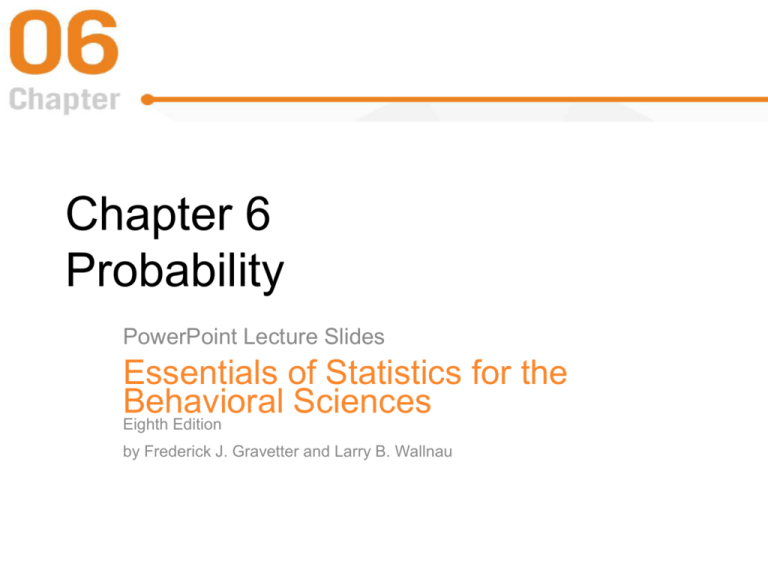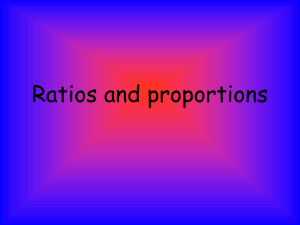Chapter 6 PowerPoint Slides
advertisement

Chapter 6 Probability PowerPoint Lecture Slides Essentials of Statistics for the Behavioral Sciences Eighth Edition by Frederick J. Gravetter and Larry B. Wallnau Chapter 6 Learning Outcomes 1 • Understand definition of probability 2 • Explain assumptions of random sampling 3 • Use unit normal table to find probabilities 4 • Use unit normal table to find scores for given proportion 5 • Find percentiles and percentile rank in normal distribution Tools You Will Need • Proportions (Math Review, Appendix A) – Fractions – Decimals – Percentages • Basic algebra (Math Review, Appendix A) • z-scores (Chapter 5) 6.1 Introduction to Probability • Research begins with a question about an entire population. • Actual research is conducted using a sample. • Inferential statistics use sample data to answer questions about the population • Relationships between samples and populations are defined in terms of probability Figure 6.1 Role of probability in inferential statistics Definition of Probability • Several different outcomes are possible • The probability of any specific outcome is a fraction or proportion of all possible outcomes number of outcomes classified as A probability of A total number of possible outcomes Probability Notation • p is the symbol for “probability” • Probability of some specific outcome is specified by p(event) • So the probability of drawing a red ace from a standard deck of playing cards could be symbolized as p(red ace) • Probabilities are always proportions • p(red ace) = 2/52 ≈ 0.03846 (proportion is 2 red aces out of 52 cards) (Independent) Random Sampling • A process or procedure used to draw samples • Required for our definition of probability to be accurate • The “Independent” modifier is generally left off, so it becomes “random sampling” Definition of Random Sample • A sample produced by a process that assures: – Each individual in the population has an equal chance of being selected – Probability of being selected stays constant from one selection to the next when more than one individual is selected • Requires sampling with replacement Probability and Frequency Distributions • Probability usually involves population of scores that can be displayed in a frequency distribution graph • Different portions of the graph represent portions of the population • Proportions and probabilities are equivalent • A particular portion of the graph corresponds to a particular probability in the population Figure 6.2 Population Frequency Distribution Histogram Learning Check • A deck of 52 cards contains 12 royalty cards. If you randomly select a card from the deck, what is the probability of obtaining a royalty card? A • p = 1/52 B • p = 12/52 C • p = 3/52 D • p = 4/52 Learning Check - Answer • A deck of 52 cards contains 12 royalty cards. If you randomly select a card from the deck, what is the probability of obtaining a royalty card? A • p = 1/52 B • p = 12/52 C • p = 3/52 D • p = 4/52 Learning Check TF • Decide if each of the following statements is True or False. T/F • Choosing random individuals who walk by yields a random sample T/F • Probability predicts what kind of population is likely to be obtained Learning Check - Answers False • Not all individuals walk by, so not all have an equal chance of being selected for the sample False • The population is given. Probability predicts what a sample is likely to be like 6.2 Probability and the Normal Distribution • Normal distribution is a common shape – Symmetrical – Highest frequency in the middle – Frequencies taper off towards the extremes • Defined by an equation • Can be described by the proportions of area contained in each section. • z-scores are used to identify sections Figure 6.3 The Normal Distribution Y 1 2 2 e ( X ) 2 / 2 2 Figure 6.4 Normal Distribution with z-scores Characteristics of the Normal Distribution • Sections on the left side of the distribution have the same area as corresponding sections on the right • Because z-scores define the sections, the proportions of area apply to any normal distribution – Regardless of the mean – Regardless of the standard deviation Figure 6.5 Distribution for Example 6.2 The Unit Normal Table • The proportion for only a few z-scores can be shown graphically • The complete listing of z-scores and proportions is provided in the unit normal table • Unit Normal Table is provided in Appendix B, Table B.1 Figure 6.6 Portion of the Unit Normal Table Figure 6.7 Proportions Corresponding to z = ±0.25 Probability/Proportion & z-scores • Unit normal table lists relationships between z-score locations and proportions in a normal distribution • If you know the z-score, you can look up the corresponding proportion • If you know the proportion, you can use the table to find a specific z-score location • Probability is equivalent to proportion Figure 6.8 Distributions: Examples 6.3a—6.3c Figure 6.9 Distributions: Examples 6.4a—6.4b Learning Check • Find the proportion of the normal curve that corresponds to z > 1.50 A • p = 0.9332 B • p = 0.5000 C • p = 0.4332 D • p = 0.0668 Learning Check - Answer • Find the proportion of the normal curve that corresponds to z > 1.50 A • p = 0.9332 B • p = 0.5000 C • p = 0.4332 D • p = 0.0668 Learning Check • Decide if each of the following statements is True or False. T/F • For any negative z-score, the tail will be on the right hand side T/F • If you know the probability, you can find the corresponding z-score Learning Check - Answer False • For negative z-scores the tail will always be on the left side True • First find the proportion in the appropriate column then read the z-score from the left column 6.3 Probabilities/Proportions for Normally Distributed Scores • The probabilities given in the Unit Normal Table will be accurate only for normally distributed scores so the shape of the distribution should be verified before using it. • For normally distributed scores – Transform the X scores (values) into z-scores – Look up the proportions corresponding to the zscore values. Figure 6.10 Distribution of IQ scores Figure 6.11 Example 6.6 Distribution Box 6.1 Percentile ranks • Percentile rank is the percentage of individuals in the distribution who have scores that are less than or equal to the specific score. • Probability questions can be rephrased as percentile rank questions. Figure 6.12 Example 6.7 Distribution Figure 6.13 Determining Normal Distribution Probabilities/Proportions Figure 6.14 Commuting Time Distribution Figure 6.15 Commuting Time Distribution Learning Check • Membership in MENSA requires a score of 130 on the Stanford-Binet 5 IQ test, which has μ = 100 and σ = 15. What proportion of the population qualifies for MENSA? A • p = 0.0228 B • p = 0.9772 C • p = 0.4772 D • p = 0.0456 Learning Check - Answer • Membership in MENSA requires a score of 130 on the Stanford-Binet 5 IQ test, which has μ = 100 and σ = 15. What proportion of the population qualifies for MENSA? A • p = 0.0228 B • p = 0.9772 C • p = 0.4772 D • p = 0.0456 Learning Check • Decide if each of the following statements is True or False. T/F • It is possible to find the X score corresponding to a percentile rank in a normal distribution T/F • If you know a z-score you can find the probability of obtaining that zscore in a distribution of any shape Learning Check - Answer True • Find the z-score for the percentile rank, then transform it to X False • If a distribution is skewed the probability shown in the unit normal table will not be accurate 6.4 Looking Ahead to Inferential Statistics • Many research situations begin with a population that forms a normal distribution • A random sample is selected and receives a treatment, to evaluate the treatment • Probability is used to decide whether the treated sample is “noticeably different” from the population Figure 6.16 Research Study Conceptualization Figure 6.17 Research Study Conceptualization Figure 6.18 Demonstration 6.1 Equations? Concepts? Any Questions ?








